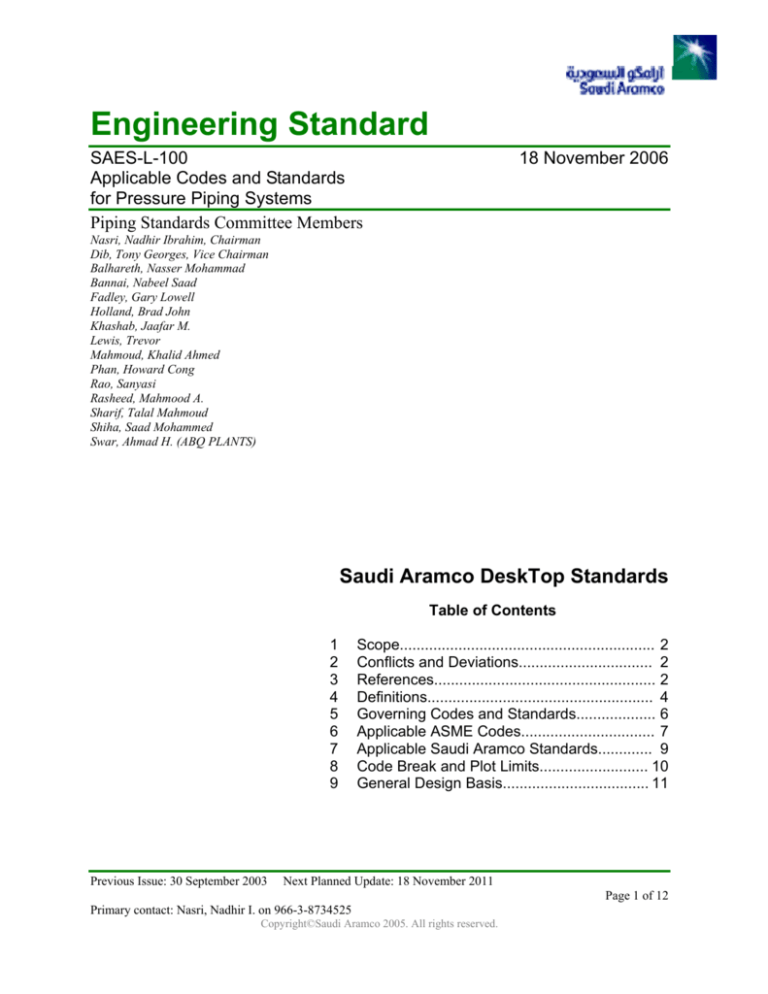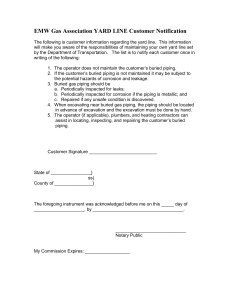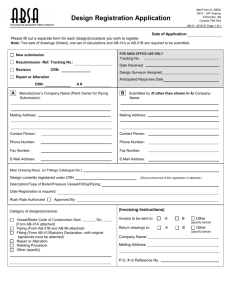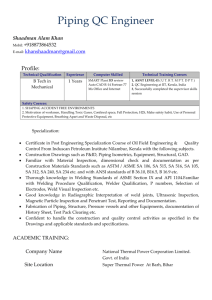
Engineering Standard
SAES-L-100
Applicable Codes and Standards
for Pressure Piping Systems
Piping Standards Committee Members
18 November 2006
Nasri, Nadhir Ibrahim, Chairman
Dib, Tony Georges, Vice Chairman
Balhareth, Nasser Mohammad
Bannai, Nabeel Saad
Fadley, Gary Lowell
Holland, Brad John
Khashab, Jaafar M.
Lewis, Trevor
Mahmoud, Khalid Ahmed
Phan, Howard Cong
Rao, Sanyasi
Rasheed, Mahmood A.
Sharif, Talal Mahmoud
Shiha, Saad Mohammed
Swar, Ahmad H. (ABQ PLANTS)
Saudi Aramco DeskTop Standards
Table of Contents
1
2
3
4
5
6
7
8
9
Previous Issue: 30 September 2003
Scope............................................................. 2
Conflicts and Deviations................................ 2
References..................................................... 2
Definitions...................................................... 4
Governing Codes and Standards................... 6
Applicable ASME Codes................................ 7
Applicable Saudi Aramco Standards............. 9
Code Break and Plot Limits.......................... 10
General Design Basis................................... 11
Next Planned Update: 18 November 2011
Page 1 of 12
Primary contact: Nasri, Nadhir I. on 966-3-8734525
Copyright©Saudi Aramco 2005. All rights reserved.
Document Responsibility: Piping
Issue Date: 18 November 2006
Next Planned Update: 18 November 2011
1
2
3
SAES-L-100
Applicable Codes and Standards
for Pressure Piping Systems
Scope
1.1
This standard defines the applicable ASME B31.1, B31.3, B31.4 and B31.8
(hereafter called the Codes) for design, construction and inspection of piping
systems owned or operated by Saudi Aramco.
1.2
This standard sets the rules and basis for selecting the applicable Saudi Aramco
Engineering Standards and/or Saudi Aramco Material Systems Specifications
that supplement the applicable Codes.
1.3
This standard supplements the Codes and defines additional design requirements
for piping systems.
Conflicts and Deviations
2.1
Any conflicts between this standard and other applicable Saudi Aramco
Engineering Standards (SAESs), Materials System Specifications (SAMSSs),
Standard Drawings (SASDs), or industry standards, codes, and forms shall be
resolved in writing by the Company or Buyer Representative through the
Manager, Consulting Services Department (CSD) of Saudi Aramco, Dhahran.
2.2
Direct all requests to deviate from this standard in writing to the Company or
Buyer Representative, who shall follow internal company procedure SAEP-302
and forward such requests to the Manager, Consulting Services Department of
Saudi Aramco, Dhahran.
2.3
Mandatory Requirements: All piping standards contain minimum mandatory
requirements, normally indicated by the words "shall" or "shall not". However,
they do not prohibit alternatives that are equal or better. In questionable cases,
the Chairman of Piping Standards Committee in CSD shall be consulted to
evaluate the alternatives.
References
The selection of material and equipment, and the design, construction, maintenance, and
repair of equipment and facilities covered by this standard shall comply with the latest
edition of the references listed below, unless otherwise noted.
3.1
Saudi Aramco References
Saudi Aramco Engineering Procedure
SAEP-302
Instructions for Obtaining a Waiver of a
Mandatory Saudi Aramco Engineering
Requirement
Page 2 of 12
Document Responsibility: Piping
Issue Date: 18 November 2006
Next Planned Update: 18 November 2011
SAES-L-100
Applicable Codes and Standards
for Pressure Piping Systems
Saudi Aramco Engineering Standards
SAES-B-064
Onshore and Nearshore Pipeline Safety
SAES-L-101
Regulated Vendor List for Pipes, Fittings and
Gaskets
SAES-L-102
Regulated Vendor List for Valves
SAES-L-105
Material Specifications for Piping Systems
SAES-L-108
Selection of Valves
SAES-L-109
Selection of Pipe Flanges, Stud Bolts and Gaskets
SAES-L-110
Limitations on Piping Joints and Components
SAES-L-120
Piping Flexibility Analysis
SAES-L-125
Safety Instruction Sheet for Piping and Pipelines
SAES-L-130
Material for Low Temperature Service
SAES-L-131
Fracture Control of Line Pipe
SAES-L-132
Material Selection for Piping Systems
SAES-L-133
Corrosion Protection Requirements for
Pipelines/Piping
SAES-L-136
Pipe Selection and Restriction
SAES-L-140
Thermal Expansion Relief in Piping
SAES-L-150
Pressure Testing of Piping Systems
SAES-L-310
Design of Plant Piping
SAES-L-350
Construction of Plant Piping Systems
SAES-L-410
Design of Pipelines
SAES-L-420
Scraper Trap Station Piping and Appurtenances
SAES-L-440
Anchors for Buried Pipelines
SAES-L-450
Construction of On-Land and Near Shore
Pipelines
SAES-L-460
Pipeline Crossings under Roads and Railroads
SAES-L-610
Non-Metallic Pressure Piping Systems
SAES-L-810
Design of Piping on Offshore Structure
SAES-L-850
Design of Submarine Pipelines and Risers
SAES-O-100
General Requirements Safety and Security
Page 3 of 12
Document Responsibility: Piping
Issue Date: 18 November 2006
Next Planned Update: 18 November 2011
3.2
SAES-L-100
Applicable Codes and Standards
for Pressure Piping Systems
Industry Codes and Standards
American Society of Mechanical Engineers
3.3
ASME B31.1
Power Piping
ASME B31.3
Process Piping
ASME B31.4
Pipeline Transportation Systems for Liquid
Hydrocarbons and Other Liquids
ASME B31.8
Gas Transmission and Distribution Piping
Systems
Other References
Safety and Security Directives
SSD/1
4
Standard Security Fence
Definitions
4.1
Conflicts between various definitions shall be resolved by the Piping Standards
Committee Chairman.
4.2
List of Definitions
Code Break: The physical location on the piping system where the design Code
changes from one Code to another, such as from ASME B31.4 to ASME B31.3.
Critical Plant Equipment and Piping: A designation imposed on equipment
or piping system that will entail extra design requirements with the objective to
minimize business interruption.
Cross-Country Pipeline: The pipeline and its appurtenances used to transport
fluids across the country or offshore between isolated plant areas or camps.
Design Agency: The agency responsible for designing the piping system. It
could be the design Contractor, the Lump Sum Turn Key Contractor or in house
design organization of Saudi Aramco.
Design Conditions: All conditions (such as pressure, temperature, ambient
conditions, service, etc.) that govern all or part of the design and selection of
piping components.
Design Factor: It is numerical multiplier used to calculate the allowable
stresses for transportation piping systems. This factor is used by ASME B31.4
and ASME B31.8 Codes.
Page 4 of 12
Document Responsibility: Piping
Issue Date: 18 November 2006
Next Planned Update: 18 November 2011
SAES-L-100
Applicable Codes and Standards
for Pressure Piping Systems
Flowlines: Pipelines connected to oil, gas or water wells for production,
injection or well testing.
Hazardous Service: Any fluid service other than Category D as defined in
ASME B31.3.
Maximum Allowable Operating Pressure (MAOP): This term refers to the
maximum pressure at which a piping system can be operated within the
provisions of the applicable ASME B31.4 and or B31.8 codes. It is the
maximum internal pressure permitted in the piping system for continued
operation at the most severe condition of coincident internal or external pressure
and temperature (minimum or maximum) expected during service.
Normal Operating Conditions: The expected conditions (such as pressure,
flow, temperature, ambient conditions, service, etc.) to occur during normal
operation per design.
Off-Plot: Off-plot refers to any area outside of the plot limits. Off-plot can
include plant areas such as roads, pipeways and open lots between plant units.
On-Plot: On-plot refers to any area inside the plot limit. On-plot piping is
generally, but not necessarily, designed to ASME B31.3 code except in area(s)
set aside for piping within other code or government regulations.
Perimeter-Fence: The fence which completely surrounds an area designated by
Saudi Aramco for a distinct function (plant or camp).
Plant-Area: The designated area engaged in the production, processing, storage
and transportation of crude oil, gas, refined products and their derivatives. It
could be inside an onshore perimeter fence, or on the decks of offshore
structures.
Plant Piping: Pressure piping system, within an identified plant-area.
Plant Utility Service: The supply of steam, water, air, nitrogen or inert gas
within a processing plant.
Plot Limit: The plot limit is a boundary, within the plant area, which surrounds
a single plant or function. The plot limit may be physical such as a fence (not
necessarily an SSD fence), a wall, the edge of a road or pipe-way, chains and
posts or a boundary indicated on an approved plot plan.
Production Pipelines: Those pipelines engaged in transporting crude oil or gas
from the producing wells to the designated facility for processing. These
include flowlines, testlines, trunklines and transmission lines.
Page 5 of 12
Document Responsibility: Piping
Issue Date: 18 November 2006
Next Planned Update: 18 November 2011
SAES-L-100
Applicable Codes and Standards
for Pressure Piping Systems
Process Piping: Pressure piping which is designed in accordance with ASME
B31.3. This piping is typically found in petroleum refineries, chemical plants,
cryogenic plants, and related processing plants and terminals.
Power Piping: Pressure piping which is designed in accordance with ASME
B31.1 and typically found in electric power generating plants.
Testlines: Flowlines that are used for testing an individual producing well
without affecting the operation of the trunklines.
Transportation Piping: Pressure piping system that is designed in accordance
to ASME B31.4 or/and 31.8. Typically, these pipelines transport hydrocarbon
fluids or others between processing plants or storage facilities to export
terminals and end users.
Trunklines: Pipelines to which two or more flowlines are connected.
Well Head Piping: The piping system connecting the wellhead to the flowline
first isolation valve.
5
Governing Codes and Standards
5.1
Except for those excluded by this standard or by the ASME B31 Codes, all
Saudi Aramco pressure piping system shall be designed, constructed and
inspected to a pre-selected ASME B31 Code as a minimum. The selection of
the Code is outlined in section 6.
5.2
Except for those excluded by paragraph 5.6 of this standard, all Saudi Aramco
pressure piping system shall be designed, constructed and inspected to the
applicable Saudi Aramco piping standards, per section 7 of this standard, in
addition to the designated ASME B31 Code.
5.3
All piping standards shall adopt the latest edition of the applicable ASME
B31.1, ASME B31.3, ASME B31.4 and ASME B31.8 Codes for pressure
piping.
5.4
In cases where applicable Code or Standards are not identified by this standard
or clear selection could not be achieved, a resolution by the Piping Standards
Committee Chairman shall be made during the early stages of the project
development.
5.5
The Standards revisions are not retroactively mandatory for piping systems built
before their dates of approval.
Page 6 of 12
Document Responsibility: Piping
Issue Date: 18 November 2006
Next Planned Update: 18 November 2011
5.6
SAES-L-100
Applicable Codes and Standards
for Pressure Piping Systems
Exclusions
The following services are excluded from the scope of ASME B31 piping codes:
6
a)
Sanitary and other gravity sewers (including oily water) in which the
internal pressure from static head and/or friction does not exceed 103 kPa
(15 psi). Refer to Saudi Aramco Plumbing and Utilities Standards.
b)
Plumbing (including fuel gas) as defined in the Saudi Aramco Plumbing
Code including the plumbing of buildings (control rooms) inside plants.
c)
Stacks, flues, vents and ducts including those for air conditioning and
ventilation.
d)
Tubes and tube fittings for boilers, heat exchangers and furnaces.
e)
Piping inside fluid handling or processing equipment (e.g., jetting piping
inside a Dehydrator).
f)
Casing, tubing and wellhead valve assemblies in gas, oil or water wells.
Applicable ASME Codes
6.1
6.2
The following piping systems are designated as Power Piping and shall comply
with ASME B31.1 as a minimum:
6.1.1
Steam power generation plants.
6.1.2
Co-generation plants.
6.1.3
Steam generating plants.
Piping systems within the following facilities shall be designated as Process
Piping and shall comply with ASME B31.3 as a minimum:
6.2.1
Refineries and petrochemical plants.
6.2.2
Gas oil separation plants (GOSP).
6.2.3
Gas plants and NGL plants.
6.2.4
Piping systems on offshore platforms except for piping beyond the code
break point, which will be considered as transportation piping.
6.2.5
Pump stations within the plot limit of a facility designated as process
piping.
6.2.6
Designated pipeways or corridors, within a Process Piping facility.
Page 7 of 12
Document Responsibility: Piping
Issue Date: 18 November 2006
Next Planned Update: 18 November 2011
6.2.7
6.3
SAES-L-100
Applicable Codes and Standards
for Pressure Piping Systems
Steam generating facilities within a Process Piping facility.
The following piping systems, in liquid service, are designated as transportation
piping and shall comply with ASME B31.4 as a minimum:
6.3.1
Cross country pipelines in hydrocarbon service having a Reid Vapor
Pressure (RVP) less than or equal to 1035 Kpa (150 psig).
6.3.2
Water injection system including pump station, headers, laterals and
pipelines.
6.3.3
Transportation pipelines in NGL service. Though its RVP is higher than
150 psig.
6.3.4
Water transportation pipelines.
6.3.5
Pump stations, including NGL service, within a dedicated facility and a
plot limit and not within a facility designated as process piping.
6.3.6
Terminals for transporting and shipping crude oil and its derivatives.
6.3.7 Bulk plants including hydrocarbon service.
6.4
6.3.8
Tank farms not within a facility designated as process piping
6.3.9
Air Fueling Terminals.
The following piping systems, in gas or multi-phase (gas and liquid) service
shall be designated as transportation piping systems and shall comply with
ASME B31.8 as a minimum:
6.4.1
Cross country pipelines in gas service.
6.4.2
Flowlines, testlines and trunklines in gas or crude oil service.
6.4.3
Gas compression stations in a dedicated facility and not within the plot
limit of a process piping facility.
6.4.4
Offshore and sub-sea flowlines and pipelines.
6.4.5
Piping systems on an offshore tie-in platforms and unmanned production
platforms.
6.4.6
Liquid sulfur transportation pipelines.
6.4.7
Cross country pipelines in crude oil service having a Reid Vapor
Pressure (RVP) more than 1035 Kpa (150 psig).
Page 8 of 12
Document Responsibility: Piping
Issue Date: 18 November 2006
Next Planned Update: 18 November 2011
6.5
7
SAES-L-100
Applicable Codes and Standards
for Pressure Piping Systems
Shop fabricated skid mounted piping, such as metering skids, shall follow the
applicable Code selected for the facilities to which it will be installed.
Applicable Saudi Aramco Standards
7.1
The SAES-L series of the piping standards are structured in the format outlined
in Table 1.
7.2
All pressure piping system, within the scope of this standard, shall be designed
and constructed per the applicable SAES assigned in Table 2.
7.3
All pressure piping system, within the scope of this standard, shall comply with
the standards listed in Table 3:
Table 1 – Numbering Structure of Piping Standards L-Series
SAES-L-
Applicable
ASME Code
Scope/Coverage
Series
Examples
100
Pressure piping within the
scope of SAES-L-100
Any of B31.1, B31.3,
B31.4 or B31.8
Refineries, bulk plant, cross country
pipeline or flowlines
300
Plant Piping: Pressure piping
within a designated plant area
Any of B31.1, B31.3,
B31.4 or B31.8
Refineries, bulk plant, tank farm or
pump station.
400
Onshore pipelines
B31.4 and or B31.8
QRT's (Qatif to Ras Tanura)
pipelines
600
Non metallic piping
Any of B31.3, B31.4
or B31.8
Qurayiah Sea Water Treatment Plant
800
Offshore Piping & Pipelines
B31.3, B31.4 or B31.8
Sub-sea pipelines offshore and
production platforms
Table 2 – Applicable Design and Construction Standards for Pressure Piping System
Application
Applicable
SAESs for Design
Applicable SAESs
for Construction
Examples
Plant piping
SAES-L-310
SAES-L-350
Refineries, bulk plant, pump
stations
On land pipelines
SAES-L-410
SAES-L-450
Pipelines in hydrocarbon or
other services
Offshore Piping systems
SAES-L-810
SAES-L-350
Offshore platform
SAES-L-850
Sub-sea pipelines
SAES-L-850
Sub-sea pipelines
SAES-L-410
SAES-L-850
Page 9 of 12
Document Responsibility: Piping
Issue Date: 18 November 2006
Next Planned Update: 18 November 2011
SAES-L-100
Applicable Codes and Standards
for Pressure Piping Systems
Table 3 - Other Applicable L-Series Engineering Standards for Pressure Piping System
Applicable
SAES-L Series
Standards
101
8
Scope of Application
Material procurement for line pipes, fittings and gaskets
102
Material procurement for valves
105
Material specifications and line class designations
108
Valves selections and material limitations
109
Selection and limitations on flanges, bolts and gaskets
110
Limitations on piping joints and components
120
Flexibility analysis and pipe supports
125
Safety Instructions Sheet for piping systems
130
Materials requirements for piping in low temperature service
131
Fracture toughness requirements for line pipe
132
Basic material selection for piping systems
133
Corrosion aspects in piping systems
136
Limitations on Carbon Steel line pipe
140
Relief requirements for piping system subject to sun radiation
150
Pressure testing of piping systems
420
Scraper Trap Station Piping and Appurtenances
440
Anchor design for buried cross onshore pipelines
460
Traffic load on line pipes at road crossings and effects of dead weight
610
Non-metallic pressure piping systems
Code Break and Plot Limits
8.1
The code break shall be defined and well established at the early stage of the
piping systems design. If the code break location is not identified according to
paragraph 8.4 of this standard, safety, practicality and economical impacts
should be always the prime justifications for selecting the physical location.
8.2
Existing code breaks should not be altered to meet new requirements or to match
newly assigned code breaks within specific facilities. Any changes to the
existing code breaks shall be approved jointly by the Piping Standards
Committee Chairman, Proponent Representative, Loss Prevention, PMT and
CSD through a letter of understanding.
8.3
In all cases, the Code break boundary between Codes shall be on the side of the
more stringent Code resulting in the higher pipe class.
Page 10 of 12
Document Responsibility: Piping
Issue Date: 18 November 2006
Next Planned Update: 18 November 2011
8.4
9
SAES-L-100
Applicable Codes and Standards
for Pressure Piping Systems
The following are recommended locations for code break:
8.4.1
Plot limits boundary, preferably the plot limit valve.
8.4.2
Emergency isolation valves located in the vicinity of the perimeter fence.
8.4.3
The isolation valve on the lateral line of an onshore scraper launcher
receiver trap.
8.4.4
For Offshore piping code boundaries:
a)
The first flanged joint on the riser above the water level is
considered the break point between piping codes ASME B31.3 and
ASME B31.4/ASME B31.8.
b)
Where a drop-out spool is installed above the riser, the break point
shall be the drop-in spool upper flange.
c)
Piping systems designed for instrument scraping capabilities, the
ASME B31.4 or B31.8 Code of the pipeline shall be extended to
the launcher / receiver barrel.
General Design Basis
9.1
It is the responsibility of the Design Agency, who is designing the piping
systems for Saudi Aramco, to identify the applicable design parameters.
9.2
Each piping system shall be designed to the most realistic condition in order to
make the constructed facility cost effective.
9.3
Piping systems shall not be design for double contingency unless the possibility
for that to occur based on HAZOP studies. The following are examples, but not
limited to, of the Contingent Design Conditions:
a)
Uncontrolled shutdown of plants, including power failure and activation of
emergency shutdown (ESD) systems.
b)
Improper operation due to a single act or operating decision, such as the
inadvertent closure of a valve, disregarding an alarm, or disabling a
protective device.
c)
Failure of a single device or function and any chain of events following a
single failure.
d)
The occurrence of fire in fire hazardous areas.
e)
Ambient conditions such as storms which have an expected average return
interval of less than 100 years.
Page 11 of 12
Document Responsibility: Piping
Issue Date: 18 November 2006
Next Planned Update: 18 November 2011
f)
SAES-L-100
Applicable Codes and Standards
for Pressure Piping Systems
Coincident unrelated contingencies or failures of more than one device
shall be considered when so specified in the SAES for specific
circumstances (such as in populated areas).
9.4
The general Saudi Aramco philosophy for protection piping system is that the
piping system shall be mechanically capable to withstand design condition
within the applicable Code requirements.
9.5
Application of High Integrity Protection Systems (HIPS) shall be per
SAES-L-310 or SAES-L-410 as applicable.
9.6
The following piping systems are considered Critical Piping or Equipment:
a)
It is part of a vital plant as defined in SAES-O-100.
b)
It is essential for the operation of the plant at design capacity.
c)
It cannot be replaced readily using materials from local stocks.
d)
It is vulnerable to damage from fire or explosion.
e)
It is in hydrocarbon service except lube oil and seal oil.
18 November 2006
Revision Summary
Major revision to section 9 addressing HIPS applications.
Page 12 of 12






